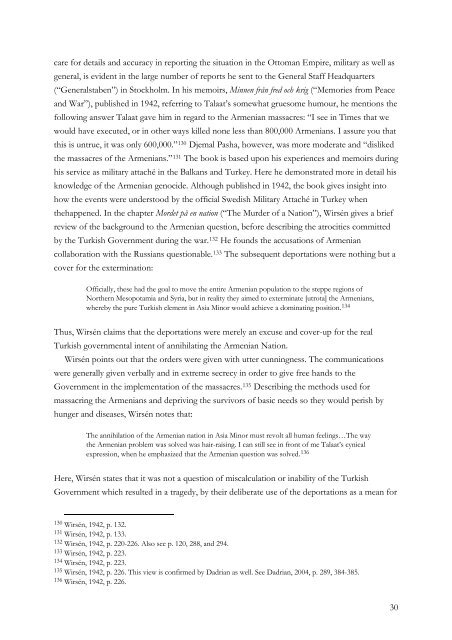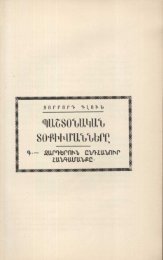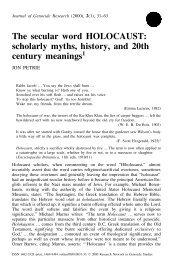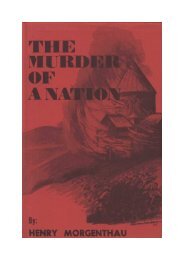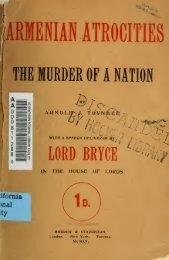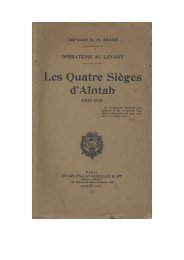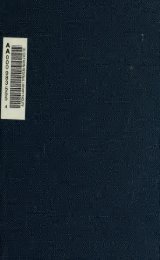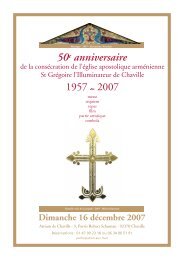care for details and accuracy in reporting the situation in the Ott<strong>om</strong>an Empire, military as well asgeneral, is evident in the large number of reports he sent to the General Staff Headquarters(“Generalstaben”) in Stockholm. In his memoirs, Minnen från fred och krig (“Memories fr<strong>om</strong> Peaceand War”), published in 1942, referring to Talaat’s s<strong>om</strong>ewhat grues<strong>om</strong>e humour, he mentions thefollowing answer Talaat gave him in regard to the Armenian massacres: “I see in Times that wewould have executed, or in other ways killed none less than 800,000 Armenians. I assure you thatthis is untrue, it was only 600,000.” 130 Djemal Pasha, however, was more moderate and “dislikedthe massacres of the Armenians.” 131 The book is based upon his experiences and memoirs duringhis service as military attaché in the Bal<strong>kan</strong>s and Turkey. Here he demonstrated more in detail hisknowledge of the Armenian genocide. Although published in 1942, the book gives insight intohow the events were understood by the official Swedish Military Attaché in Turkey whenthehappened. In the chapter Mordet på en nation (“The Murder of a Nation”), Wirsén gives a briefreview of the background to the Armenian question, before describing the atrocities c<strong>om</strong>mittedby the Turkish Government during the war. 132 He founds the accusations of Armeniancollaboration with the Russians questionable. 133 The subsequent deportations were nothing but acover for the exter<strong>min</strong>ation:Officially, these had the goal to move the entire Armenian population to the steppe regions ofNorthern Mesopotamia and Syria, but in reality they aimed to exter<strong>min</strong>ate [utrota] the Armenians,whereby the pure Turkish element in Asia Minor would achieve a do<strong>min</strong>ating position. 134Thus, Wirsén claims that the deportations were merely an excuse and cover-up for the realTurkish governmental intent of annihilating the Armenian Nation.Wirsén points out that the orders were given with utter cunningness. The c<strong>om</strong>municationswere generally given verbally and in extreme secrecy in order to give free hands to theGovernment in the implementation of the massacres. 135 Describing the methods used formassacring the Armenians and depriving the survivors of basic needs so they would perish byhunger and diseases, Wirsén notes that:The annihilation of the Armenian nation in Asia Minor must revolt all human feelings…The waythe Armenian problem was solved was hair-raising. I can still see in front of me Talaat’s cynicalexpression, when he emphasized that the Armenian question was solved. 136Here, Wirsén states that it was not a question of miscalculation or inability of the TurkishGovernment which resulted in a tragedy, by their deliberate use of the deportations as a mean for130 Wirsén, 1942, p. 132.131 Wirsén, 1942, p. 133.132 Wirsén, 1942, p. 220-226. Also see p. 120, 288, and 294.133 Wirsén, 1942, p. 223.134 Wirsén, 1942, p. 223.135 Wirsén, 1942, p. 226. This view is confirmed by Dadrian as well. See Dadrian, 2004, p. 289, 384-385.136 Wirsén, 1942, p. 226.30
the annihilation. General von Lossow, the German military attaché in Turkey, had in a privateconversation confessed the following to Wirsén: “The Armenian massacres are world history’sgreatest bestiality.” 137The military reports and dispatches sent by Wirsén were extracted fr<strong>om</strong> former classified data,kept in the War Archive in Stockholm. These dispatches were mainly on the status of theongoing war efforts and the reports of the different fronts in which the Ott<strong>om</strong>an Army wasinvolved. Almost all his reports are structured in the same manner, beginning with a detailedreport in regard to the military operations and the situation on different fronts, and they end witha general description of the situation in the country. 138 It is mostly in these general descriptionswhere Wirsén mentions Turkish actions against the Armenian population, which in their turnaffect the war efforts. Judging fr<strong>om</strong> the published pictures in the book, taken in different parts ofthe Ott<strong>om</strong>an Empire, Wirsén did travel around in Turkey, collecting s<strong>om</strong>e of the informationstated in his reports by his own observations, while he also used a great deal of official Germanand Turkish military intelligence information as well as unofficial accounts provided by Germanmilitary personnel.The military reports are of great importance, since the Swedish Military Attaché, as arepresentative of a neutral state, was allowed to visit the fronts and gather information about theongoing campaigns and actions in Ott<strong>om</strong>an Turkey. He also received military intelligence reports,dispatched not only by the Turks but also by the Germans and Austrians serving in the Ott<strong>om</strong>anArmy. The reports were ciphered and relayed to Sweden and provided the Swedish ForeignOffice and Chiefs of Staff with first hand intelligence information about the events insideOtt<strong>om</strong>an Turkey. The studied reports will also disclose that Wirsén took the liberty torec<strong>om</strong>mend Stockholm about certain actions towards both Turkey and Germany, which suggeststhat his analytic reports were of importance to the Swedish foreign policy making.1.4.5 Swedish Embassy, Foreign Department, and GovernmentThe dipl<strong>om</strong>atic c<strong>om</strong>muniqués and reports, dispatched by the Swedish Embassy personnel in theOtt<strong>om</strong>an Empire, included in the Foreign Ministry Files (“Utrikesdepartementet, HP-serien”) arekept almost entirely in the National Archive in Marieberg, Stockholm. These reports, mostlymarked as classified, if anything would indicate whether the Swedish Government and ForeignMinistry were informed about the massacres, as well as how they were described and perceived.In order to gather the information studied in this paper, several volumes and series of archivalmaterial were investigated. Initially, the search started with the classified dipl<strong>om</strong>atic dispatchessent by the Embassy to the Foreign Ministry during 1915 and 1923. The documents in questionwere divided in two distinct series, entitled Utrikesdepartementet 1902 års dossiersytem, respective137 Wirsén, 1942, p. 226.138 See Krigsarkivet, Generalstaben. It is noteworthy that the following material has been classified as militaryand state secret, but that can hardly be the reason for its anonymity, since these documents have been publicfor the last thirty years or so.31
- Page 3 and 4: 1 Introduction.....................
- Page 5 and 6: War, rather confirm the version of
- Page 7 and 8: 1.2 Previous ResearchWhen discussin
- Page 9 and 10: Military Attaché and the missionar
- Page 11 and 12: situation: “It is a crime when Te
- Page 13 and 14: in the following investigation, whi
- Page 15 and 16: killed. The slaughterer slaughtered
- Page 17 and 18: interests. Despite his famous “14
- Page 19 and 20: morality, balance of power, or the
- Page 21 and 22: 4. International organisations (e.g
- Page 23 and 24: warring parties. 104 This observati
- Page 25 and 26: Concerning the protocols of the Swe
- Page 27 and 28: present in Turkey. These documents
- Page 29: He also mentions meeting an Armenia
- Page 33 and 34: 1.5 BackgroundIn order to understan
- Page 35 and 36: 1914, when two inspector-generals f
- Page 37 and 38: to Islam or were sold as slaves to
- Page 39 and 40: 2 Empirical AnalysisThe empirical r
- Page 41 and 42: It does not seem to be the Turkish
- Page 43 and 44: The Turks claim that, at the Russia
- Page 45 and 46: The Armenian population has equippe
- Page 47 and 48: 1917 was the revival year for the A
- Page 49 and 50: Even if the communication between t
- Page 51 and 52: implemented against the Armenian na
- Page 53 and 54: Anckarsvärd continued claiming tha
- Page 55 and 56: Germany is blamed for its accessory
- Page 57 and 58: Here Wirsén took the liberty to co
- Page 59 and 60: On February 19, news of new Armenia
- Page 61 and 62: estricted to the fields of intrigue
- Page 63 and 64: generous offer of President Wilson
- Page 65 and 66: Lange gave a detailed description o
- Page 67 and 68: skin was totally scorched. Another
- Page 69 and 70: which her recurrently emphasised th
- Page 71 and 72: The sooner calls referring to the A
- Page 73 and 74: Despite these facts, Armenia was th
- Page 75 and 76: Svenska Riksarkivet [Swedish Nation
- Page 77 and 78: Bakhtiari, Kalla det vad fan du vil
- Page 79 and 80: Chan, Steve and Drury, Cooper A., S
- Page 81 and 82:
Moranian, Suzanne Elizabeth, Bearin


